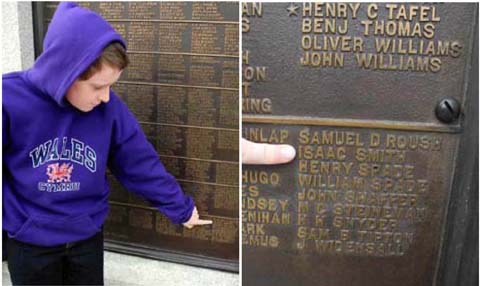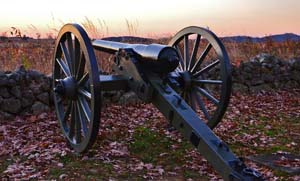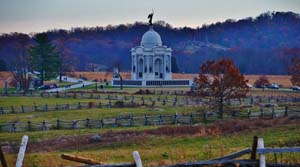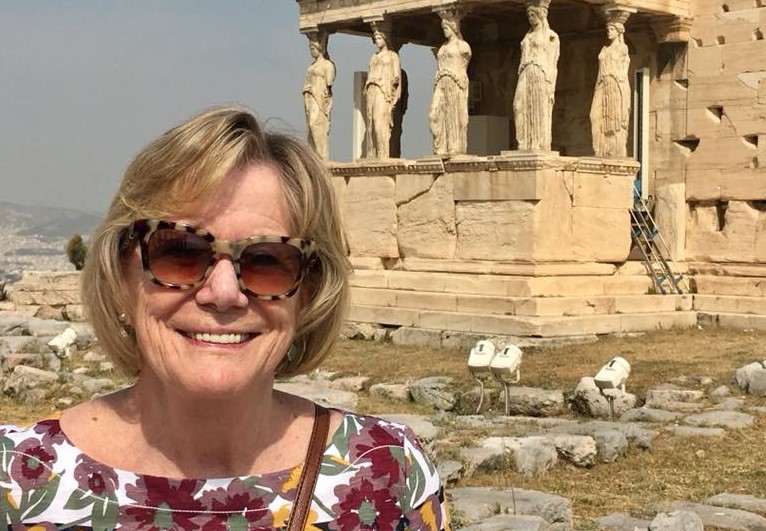“Four score and seven years ago our fathers brought forth, upon this continent, a new nation, conceived in liberty and dedicated to the proposition that all men are created equal. Now we are engaged in a great civil war, testing whether that nation, or any nation, so conceived and so dedicated, can long endure.”
One of my brothers lives in Kentucky, one in Pennsylvania and the rest of us in New England so we chose Gettysburg, Pennsylvania, for a family get-together to celebrate a few recent family milestones. It seemed to be right in the middle, some cousins lived relatively nearby in Baltimore, and, as an added bonus, our collective great grandfather, Isaac Smith, had fought there with the Pennsylvania 62nd Infantry Regiment http://www.icyousee.org/pa62d/smithletter.html.
 We visited Gettysburg right before the celebration of the 150th anniversary of President Abraham Lincoln’s immortal Gettysburg Address, which is Tuesday, Nov. 19, 2013. The red, white and blue bunting out in anticipation of the event added a definite air of festivity to the actual town, while the battlefields themselves and the stories behind them gave new meaning to Lincoln’s mere 272 words.
We visited Gettysburg right before the celebration of the 150th anniversary of President Abraham Lincoln’s immortal Gettysburg Address, which is Tuesday, Nov. 19, 2013. The red, white and blue bunting out in anticipation of the event added a definite air of festivity to the actual town, while the battlefields themselves and the stories behind them gave new meaning to Lincoln’s mere 272 words.
“We are met on a great battle-field of that war. We have come to dedicate a portion of that field, as a final resting place for those who here gave their lives that that nation might live. It is altogether fitting and proper that we should do this. But, in a larger sense, we can not dedicate — we can not consecrate — we can not hallow — this ground. The brave men, living and dead, who struggled here, have consecrated it, far above our poor power to add or detract.”

By Karen Cummings
The story of the battle is almost too terrible to be true — I still can’t get over the sheer numbers who died there (more than 50,000), the whole image of Pickett’s Charge (12,000 men crossing an exposed field directly into enemy fire) and how little differences could have made it all go the other way (and change history forever). Plus, not only did my great grandfather fight there, but he survived the bloodiest battle in America’s bloodiest war.
There is a wide choice of hotels in Gettysburg, ranging from the historic to the modern chains, but my daughter, 10-year-old grandson and I chose to stay in the Quality Inn at General Lee’s Headquarters along Buford Avenue to the west of town. We quickly learned that Buford was the Kentucky general who first encountered the southern forces on the ridge that we looked out on from our hotel. He and his troops bravely engaged them for most of day one of the battle (July 1 to 3, 1863) in an effort to delay their advance so more northern forces could gather.
The free General Lee’s Headquarters Museum, a circa 1830s stone building right at our hotel, was our first introduction to the history of Gettysburg. Small, with authentic weapons, furniture, clothing and historic artifacts, it whet our appetites to see and learn more.
 We then headed to the National Park Service and Visitor Center, which houses the extensive Gettysburg Museum of the Civil War, the completely restored Gettysburg Cyclorama, a gift/book shop and hosts the film, “A New Birth of Freedom,” which joins the museum in explaining the causes that led to the war, in addition to detailing the three days at Gettysburg that were the war’s acknowledged turning point.
We then headed to the National Park Service and Visitor Center, which houses the extensive Gettysburg Museum of the Civil War, the completely restored Gettysburg Cyclorama, a gift/book shop and hosts the film, “A New Birth of Freedom,” which joins the museum in explaining the causes that led to the war, in addition to detailing the three days at Gettysburg that were the war’s acknowledged turning point.While all of that was fascinating and extremely well done, at Gettysburg, it’s the battlefields themselves that speak volumes. All of them are lined with monuments. Some erected by the states who lost men there, both northern and southern. Some are to regiments. Some are to individuals. All tell a different part of the story.
“The world will little note, nor long remember what we say here, but it can never forget what they did here. It is for us the living, rather, to be dedicated here to the unfinished work which they who fought here have thus far so nobly advanced.”
The National Park Service has a brochure that offers a self-guided driving tour of the battlefields, a walking tour and a brief overview of the three days of battle. They also have an in-depth brochure for a walking tour of the Soldier’s National Cemetery that Lincoln dedicated that day. Visitors can also take Segway tours, a self-guided audio tour, bike through the park and even ride horses on pathways specifically dedicated to horseback riding.
 With our large group and rather limited time, we opted for a two-hour bus tour conducted by a Licensed Battlefield Guide. His often highly animated descriptions of the conflict made the soldiers, the horses, the chaos, the death, the suffering appear before our eyes — all of us, from aged 10 to 70 – as we followed his instructions and looked out over the windswept and beautifully preserved fields to the right and the left of the bus.
With our large group and rather limited time, we opted for a two-hour bus tour conducted by a Licensed Battlefield Guide. His often highly animated descriptions of the conflict made the soldiers, the horses, the chaos, the death, the suffering appear before our eyes — all of us, from aged 10 to 70 – as we followed his instructions and looked out over the windswept and beautifully preserved fields to the right and the left of the bus.His puns, such a talking about General Sickles’ “legacy,” might have brought groans from all of us, but they made us remember the story. (Sickles had his leg that was blown off in battle preserved and put on display.) One favorite sight was seeing light through a barn near its peak via the cannon ball hole on either end.
We saw the sites of the battles from day one through to the fateful day three. His explanation of the strategy and the successes and failings on both sides illustrated why “taking the high ground” was so important and helped to explain somewhat why General Lee would order the ill-fated Pickett’s Charge.
 We have all come away with a new respect for the sheer bravery of the men who fought in that terrible war and that terrible battle, including for Isaac Smith, our Great, Great-Great, and Great-Great-Great Grandfather.
We have all come away with a new respect for the sheer bravery of the men who fought in that terrible war and that terrible battle, including for Isaac Smith, our Great, Great-Great, and Great-Great-Great Grandfather.And now, Lincoln’s words have even more meaning to all of us. I cannot recommend enough that every American man, woman and child visit this hallowed site.
“It is rather for us to be here dedicated to the great task remaining before us — that from these honored dead we take increased devotion to that cause for which they gave the last full measure of devotion — that we here highly resolve that these dead shall not have died in vain — that this nation, under God, shall have a new birth of freedom — and that government of the people, by the people, for the people, shall not perish from the earth.”
All photos by Howard Smith unless otherwise noted.
 To celebrate the 150th anniversary of the Gettysburg Address, documentarian Ken Burns, along with numerous partners, has launched a national effort to encourage everyone in America to video record themselves reading or reciting the speech. The collection of recordings housed on this site will continue to grow as more and more people are inspired by the power of history and take the challenge to LEARN THE ADDRESS.
To celebrate the 150th anniversary of the Gettysburg Address, documentarian Ken Burns, along with numerous partners, has launched a national effort to encourage everyone in America to video record themselves reading or reciting the speech. The collection of recordings housed on this site will continue to grow as more and more people are inspired by the power of history and take the challenge to LEARN THE ADDRESS.

After several decades working in a variety of jobs as a newspaper writer, event publicist, communications specialist, and marketing director, Karen Cummings is now “retired” and working on Travelers United’s social media and newsletters in addition to occasionally contributing a travel-related article to TU’s blog. She lives close to her family in Fryeburg, Maine, and travels as often as she can.



